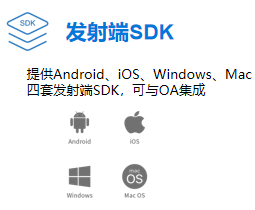Native standard screen mirroring protocol:
Compatible with native screen mirroring protocols such as Airplay, Miracast, Google Cast, and DLNA, as well as wired screen mirroring via USB data cable, it fully adapts to chip platforms such as HiSilicon, Amlogic, Rockchip, Sigmastar, Quanzhi, and Intel, making it convenient for chip manufacturers, set-top box manufacturers, TV manufacturers, and device integrators to integrate.

Bijie Private Screen Projection Protocol:
The BJCast transmitter SDK provides SDKs for Windows, MacOS, Android 5.0+, and iOS platforms. Users can integrate the transmitter SDK into their own apps or software applications, and match it with the Bijie screen mirroring receiver device to achieve wireless mirroring for mobile phones, tablets, and PCs.

Design schematic diagram of transmitter SDK and receiver SDK

- Perfect support for mirror screen mirroring, URL screen mirroring, and music screen mirroring
- Support YouTube screen mirroring (suitable for overseas users)
- Perfectly compatible with Tencent Video and YouTube in URL mode
- Support multiple screen mirroring, users can set the maximum number of screen mirroring channels
- Support resolution and frame rate negotiation
- The SDK interface is easy to integrate and provides demo source code, which has been widely used by many customers and is mature and stable
- Support Windows/Android/Linux platforms (depending on user needs, special platforms require cross compilation)
- Cloud License Authorization, Multiple Authorization Methods, Supporting Overseas Authorization
- License service provides management backend, query and export authorization report functions
- Supports Android/Windows Miracast functionality
- Good compatibility, years of research and development accumulation, actual compatibility testing has been conducted on over 100 devices
- Compatible with over 20+WiFi modules, including Broadcom, Qualcomm, and Realtek
- Supports multiple screen mirroring, while traditional Miracast can only support one screen mirroring
- Support keyframe requests, frame loss handling, etc
- Supports Windows mouse independent channel and HDCP (optional)
- Support Android/Linux platforms (depending on user needs, special platforms require cross compilation)
- Cloud License Authorization, Multiple Authorization Methods, Supporting Overseas Authorization
- License service provides management backend, query and export authorization report functions
-
Implement DLNA MediaRender functionality -
Support the TV casting function of video players such as iQiyi and Youku -
Support pause, play, progress bar drag, stop and other functions on mobile devices -
Support image projection function -
Support Android/Windows/Linux platforms, provide C/C++integration interface, Android provides AAR for application integration -
Receiving cloud based license authorization, multiple authorization methods, supporting overseas authorization -
License service provides management backend, query and export authorization report functions
-
Support Google Cast mirroring on Chrome browser/Chrome Book/Android phone (requires support from Android phone) -
Support multiple transmitting terminals to simultaneously project screens -
Currently supports Android platform, other platforms can be customized and ported according to customer needs -
It can run on regular Android devices without relying on Google services -
Android provides AAR format for customers to integrate -
Receiving cloud based license authorization, multiple authorization methods, supporting overseas authorization -
License service provides management backend, query and export authorization report functions
-
Android devices are connected to the receiving device using a Typec data cable, and the receiving device automatically plays the Android device screen. -
Android devices require USB debugging option to be enabled
-
Apple devices use the official Apple data cable to connect to the receiving device, and the receiving device automatically plays iPhone/iPad device images and audio
-
Support mirror projection of BJCast emitter applications for Windows/Android/MAC/iOS versions -
Self developed independent mouse channel (Windows projection mouse is smoother) -
Users can implement extended scanning and screen casting/screen casting code screen casting functions based on SDK -
Simultaneously supporting multiple BJCast transmitters to project screens simultaneously -
Support setting transmission protocol UDP/TCP, critical requests, and link anomaly detection -
The receiving end supports Android/Windows/Linux platforms -
The receiving end provides a c/c++integrated interface, and Android provides an aar module -
Receiving cloud based license authorization, multiple authorization methods, supporting overseas authorization -
License service provides management backend, query and export authorization report functions
-
Provide SDKs for Windows, MacOS, Android 5.0+, and iOS platforms -
Equipped with screen capture and hard coded network transmission functions -
Windows can provide c/c++/c #, Node.js Electron addon interface -
The MacOS platform provides the Object c/node. is Electron addon interface -
Android SDK provides AAR integration package and Java interface -
The iOS platform provides an Object C interface and has the ability to call iOS Airplay or iOS screen recording -
Provide easy integration interface, with a cycle of 1-2 weeks
- The role of transmitting audio and video data.
- SDK can be integrated into user apps (supporting Windows/Android/iOS/MacOS clients)
Receiver:
- The role of receiving audio and video data and processing it accordingly.
- Implement BJCast, Airplay, Miracast, and DLNA receiver protocol stacks to receive audio and video streams
- Provide secondary development interface for the receiving end
- Can run on teaching all-in-one machines/central control consoles/PC computers, etc
- Supports Android and Windows operating systems
- In a system where multiple receiving devices interact, divide multiple receiving devices into an interactive group
- By default, each role of the receiving device in the dynamic group uses multicast to achieve data transmission (multicast supports 1-to-many, which can effectively reduce the sending bandwidth of the sending end during broadcasting).
- The devices within the current interactive group are using the BJCastGroup group management protocol.
- Create/Delete/Join/Exit Group
- Push/pull flow and other operations
- SDK includes screenshot encoding and decoding
- Transfer audio and video streams between groups
- Can run on teaching all-in-one machines/central control consoles/PC computers, etc
- Supports Android/Windows systems
- There is a domain ID, and different groups need to use different values through configuration constraints
- There is a main device within the group
- There are multiple slave devices within the group
- Managed by the master device, each slave device is identified by an agentID


To achieve “one-to-one screen mirroring” for each guest room and avoid the phenomenon of similar rooms being mistakenly or randomly projected, a common network maintenance solution is to prepare a separate AP or router for each guest room, which incurs high costs. With the help of Bijie Internet’s screen casting hotel solution, there is no need for a hardware gateway, supporting cross layer networks, unrestricted networks or IPTV private networks, and creating a smart hotel screen casting lifestyle with one APP/SDK.

 glass
glass
Integrating the SDK into smart glasses allows for the projection of games from VR glasses onto televisions, providing a wider user experience. Alternatively, the game on the computer or mobile phone can be projected onto VR glasses, giving users a sense of immersion.

Car navigation system
Integrate the SDK into the car navigation system and directly project it onto the car’s infotainment system when navigation is needed. The infotainment system has a larger screen and clearer map display, making it easier for drivers to view navigation information while driving. Some infotainment systems can also project the navigation onto the instrument screen, so drivers do not need to shift their gaze to the central control screen. They only need to look at the dashboard, making driving safer.

Display large screen
Integrate SDK into the display screen, support 1080p high-definition display, wireless screen mirroring for mobile phones and computers, and switch between large and small screens at will; IQiyi, Youku, Tencent Video and other APP videos can be directly displayed on the screen, which is simple and easy to use.

Smart Home
Integrating SDK into smart homes, people can optimize their lifestyle and living environment by projecting recipes onto a range hood with a small screen, projecting food preservation temperature onto a refrigerator with a screen, projecting skincare steps onto a mirror with a screen projection function, and other operations, helping people effectively arrange time and save various energy.

cooperative partner
